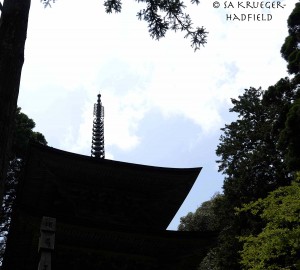We left Hokkaido and flew to Osaka where we collected our next rental car (our first teeny tiny one!)
As our flight was delayed due to weather in Hokkaido, we decided to break the journey between Osaka and Obama (it means “little ocean” in Japanese) in Kyoto.


The Ninomaru Palace of the Nijo-jo, the shogun’s residence!
The “nightingale floors” (uguisubari) in the corridors protected the occupants from sneak attacks and assassins. The floors squeak as you walk and sound like nightingales!
We set off to Obama in order to sample Gracilaria populations as well as meeting Dr. Mitsunobu Kamiya, a researcher I’d long desired to meet! In the Edo period, Obama was the capital of the Obama Domain. The connection between Obama and Kyoto was and still is an important sea route from the Sea of Japan coast to the rest of Japan.
Kamiya-San, John West and Joe Zuccarello have embarked on elegant studies of reproductive patterns in red algae (e.g., Kamiya et al. 1998 J Phycol 34: 361–370; West et al. 2001 J Phycol Res 49: 183–200; Kamiya and West 2010 Red Algae in the Genomic Age pp. 77-109). The mechanisms by which apomixis arises in diverse red algal lineages is not well understood but Kamiya-San and colleagues (2011; J Phycol 47: 753–762) provided evidence of outcrossing between genetically divergent sexual entities is one of the factors inducing apomixis in the red alga Caloglossa leprieurii.
Upon our arrival, I was given the opportunity to speak about my research on algal reproductive systems and was tickled by the advertisement of my seminar in Japanese!

My seminar advert … couldn’t resist a picture with it and liberating it after my seminar was completed!
Kamiya-san invited one of his students, Taku Ogawa, to accompany us on our field work. Ogawa-San has led and been part of several studies in the lab addressing patterns of green algal speciation along salinity gradients in Mikata-goko (goko means five lakes).
There are five lakes directly or indirectly connected to the Sea of Japan with variation in salinity throughout the mostly-interconnected system, except for the completely marine Lake Hiruga.
In the genus Cladophora, culture experiments revealed optimal salinity conditions for vegetative growth varied among ribotypes collected from different salinity regimes (Hayakawa et al. 2012 Phycol. Res. 60: 86-97). The distributions of the different Cladophora species were likely controlled by ribotype-specific ecophysiological adaptations.
Likewise, Ogawa and colleagues (2013 Phycologia 52: 637-651) found evidence for similar ecotypic variation in Ulva species along these salinity gradients.

Seasonal fluctuation of the ulvoid species composition at the sites sampled in Mikata-goko and the Minami River from Ogawa et al. (2013 Phycologia 52: 637-651).
In a subsequent study, Ogawa and colleagues (2014 Aquatic Botany 120:185-192) explored the apomictic reproduction of U. prolifera.

Eight collection sites in Mikata-goko and the Minami River and the respective genetic composition in Ulva prolifera (Ogawa et al. 2014 Aquatic Botany 120: 185-192).
For fertilization, positively phototactic gametes swim upward in the water column toward the light and may, therefore, encounter other gametes. However, for the apomictic U. prolifera, there is no need to swim upward. Rather, the phototactic variation found by Ogawa and colleagues (2014) likely had a different ecological mechanism.
The positively phototactic zoids were found in the genotypes present throughout Mikata-goko. By swimming upwards, it may be possible to disperse throughout the interconnected lakes. By contrast, the other five genotypes released negatively phototactic zoids. These genotypes were found in high-salinity brackish sites in Mikata-goko and the Minami River where the currents are swifter. Thus, swimming downwards may keep these genotypes in their preferred salinity and contributes to adaptation to various salinity regimes.
We were able to learn about the above research as we drove to our first Gracilaria site near Hayase.
Along the way, we stopped at a site near an aquarium between Obama and Mikata-goko. Kamiya-San is active with the aquarium and outreach events introducing snorkeling to budding scientists as well as the importance of algae.
We were looking for another red seaweed which may in fact have a larger introduced distribution than G. vermiculophylla! Alas, we didn’t find it, but we did get to explore the intertidal, a behind the scenes tour of the aquarium and a parting gift from the aquarium staff.

Small gift for Rob and I from the aquarium staff. They are a local freshwater clam called shijimi. These are now hanging in our house and a memory of the hospitality of our Japanese hosts.
These small clams were once abundant in Mikata-goko, but now researchers are trying to determine their abundances following the development of sea walls and coastal protection.
We also stopped along the way to sample local delicacies and look at beautiful chopsticks before stopping at site near the Minami River for some more ogo-nori.

On our way back to the airport, we, first, stopped at the fish market in Obama.





We, then, visited the Jingū-ji Temple.



Next stop: Sendai and Tohoku University!













